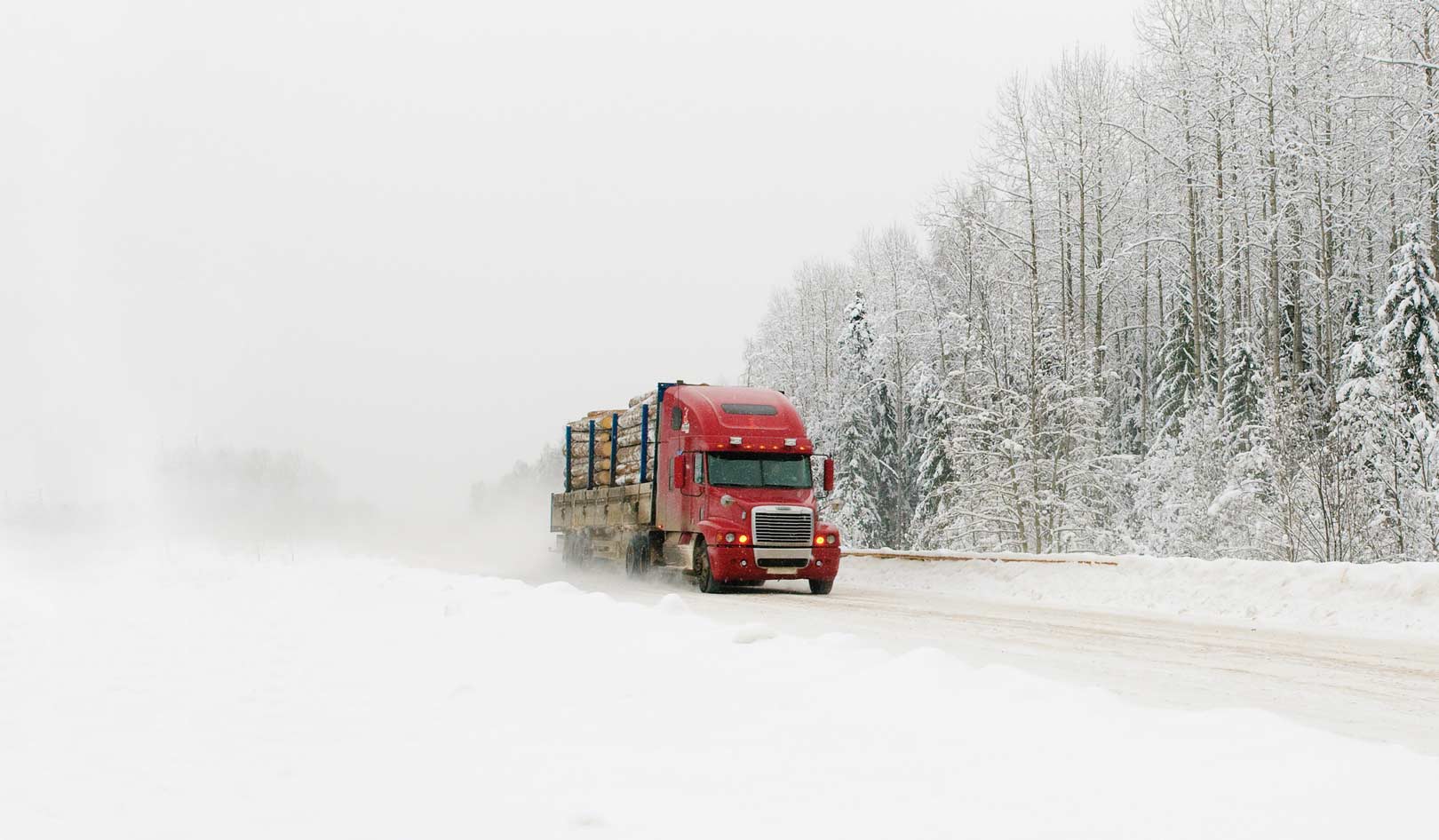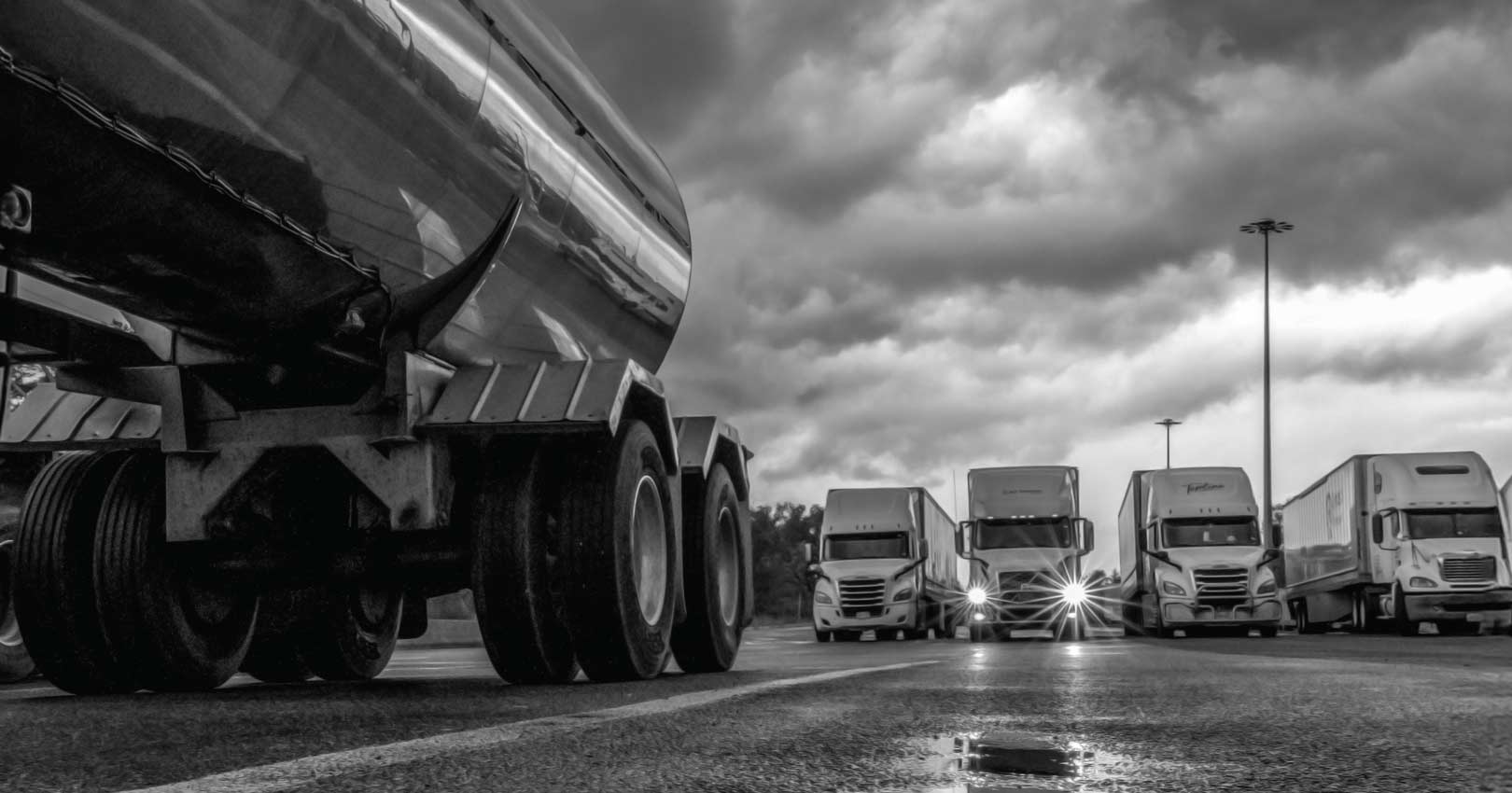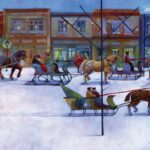


A new breed of trucker is plying the highways, leaving the romance of long-haul trucking in the rearview mirror.
The rapping on the car window was sharp and insistent. A guy in a neon yellow safety vest cinched over a faded T-shirt loomed. He was … well, big. The kind of big that comes from sitting in a truck for ten, twelve hours a day.
“I was wonderin’ what you were doing taking pictures of my truck.” “No, no, no. Not taking pictures, taking notes. That’s all.” An awkward pause. “Where are you going? Calgary? Winnipeg?”
“Nah … Ottawa and back. That’s it. Do it every day.” His white truck with its fifty-three-foot trailer was sitting in the Trenton ONroute off the eastbound 401.
“Don’t you do long distance?”
“Not anymore. None of the guys do – not many at least. There’s no money in it.” He snorted. “Hell, dinner is thirty bucks. Those days are done … pretty much.”
He wasn’t about to say any more. “I gotta get back to work.” He climbed back into his truck, swung disdainfully around the car with an inch to spare, and as he slid back onto the highway, he took any notion of the romance of trucking with him.
If you bought it, a trucker brought it – It was 9:00 a.m. and there were maybe 20 trucks behind the ONroute that day: a giant bright yellow Safety Kleen tanker that collects used oil, a couple of flatbeds, and several unassuming tractor trailers, one with a Quebec licence plate and the TFI International logo. TFI is the biggest trucking company in the country. It bought UPS freight four years ago for $800 million. There are roughly 50,000 trucking businesses in Canada, employing 400,000 people.
Trucking is big business. The trailers cost around $150,000, tires $400 to $700 each, newish trucks that pull the trailers another $150,000. Those trucks and their trailers can be an investment of $300,000 or more. Trucks haul nearly 80 percent of goods in Canada.
The ONroute might not have been full that morning, but the highway was. There are as many as 50,000 trucks a day trundling down the 401. No one talks about 18 wheelers any more. These days it can be 32 wheelers that can carry 60,000 pounds of freight. There are tanker trucks, dump trucks, flatbeds, soft-sided trucks, trucks with double trailers. Head down the 401 in either direction and there’s almost always a truck of some sort in sight.
The 401 is – at 18 lanes wide in places – the widest highway in North America and the busiest. “That road is busy 24/7. It’s staggering,” says Richard Brown, who built Rogue Transportation, a trucking company that specializes in delivering pharmaceuticals.
A 53-foot Rogue Transportation truck and trailer pushes down the highway near Cobourg. A big blue and red building profile decorates the side of the trailer. Rogue is, for the most part, a regional carrier running “reefers” – refrigerated trucks. The company started forty years ago and has always carried medicines to hospitals, drug stores and veterinary practices along with autoclave machines and ultra cold refrigerators.
It was a solid business – then in 2018, Canada legalized marijuana. “It’s rare you get a new industry with new demand,” says Richard Brown. “We jumped on it.” (Suddenly “reefers” had a new meaning.) Moving cannabis needed temperature-controlled trailers for cannabis gummies, for cannabis chocolate, beverages, gelatins, anything susceptible to spoilage. “Even plain weed can’t get too warm or mould will develop.” Brown, who has a marketing background, developed Rogue Transportation from four trucks and two loading docks to twenty-three docks and a hundred trucks and sold the company to a billion-dollar enterprise.
“Yeah, the 401 is a good road,” says Brown. “Straight, reasonably well maintained. Today the weather is the biggest issue. Blowing snow can be a problem.” Nothing compared to those two-lane roads in Northern Ontario.
“That ‘cowboy on the open road thing’ – it’s all pretty well gone. Back in the 70s there was a brotherhood… Now, there’s not much room for rugged individualism. It’s way more corporate.” RAY STEWART
The bigger the truck, the bigger the adventure – Ray Stewart started driving for his father’s company, Cobourg Cartage. “Northern Ontario, out west, it’s one big convoy all day every day.” Now he and his brothers have a trucking company that employs 5,000 people in Canada and the U.S.
You can’t talk to a trucker without catching one or two of their sayings: “Meet me where the rubber hits the road,” “My truck, my rules”… But they ring hollow; the game has changed. Long-haul trucking is down; it’s being replaced by inter-modal transportation – transfers from train or ship to truck. “That makes economic sense,” according to Stewart. He also knows that for truckers, “That ‘cowboy on the open road thing’ – it’s all pretty well gone. Back in the 70s there was a brotherhood. Truckers would raise a hand, salute each other as they passed. Now, there’s not much room for rugged individualism. It’s way more corporate.” The business is also one of the most regulated in the country. Companies have consolidated and embraced the word of the day – logistics.
As Richard Brown knows, “The big companies got big because they’re smart and well organized.”
In the immortal words of former Alaska governor Sarah Palin, “Buck up or stay in the truck.”
If wheels aren’t turning … you’re not earning – Head east down the 401 and just outside Napanee you come to the Flying J truck stop. With 750 locations and 28,000 employees mainly in the U.S., it’s the top-of-the-line of truck stops. Warren Buffet must have liked the profit margins on beef jerky and diesel fuel. Buffet’s Berkshire Hathaway bought Flying J eight years ago.
There are 10 shiny red Peterbilt trucks, the Cadillacs of the truck world, parked neatly in a row, their chrome exhaust chimneys and grills glistening in the sun. Deeper in the parking lot there’s a blue soft-sided trailer with the words “Hit Me Hard and Soft. The Billie Eilish tour,” and off to one side a “Landstar” truck out of Jacksonville Florida that is in a bad way. The trailer is resting on its dollies, the massive truck hood is tipped forward and the driver has his head inside the engine. Many short-haul drivers make between $25 and $35 an hour, but long-haul drivers are usually paid by the mile. For this Jacksonville Florida driver, an idle truck amounts to a bad day.
Another driver slides out of his cab, pads across the asphalt, dumps his neatly tied garbage into the big bin and heads into the super-sized truck convenience store. Giant truck wiper blades, cutting pliers, warning flags, Gorilla tape and CB microphones hang on the wall. Big thick books of old fashioned maps, microwavable food, and bottles of pain relievers fill the shelves. Then there are gloves, sisal rope, something called poly rope and 500-pound yellow winch straps. Anything to keep the wheels turning.
The loudspeaker announces that a shower is available. The Napanee truck stop has 15 showers, 165 parking spaces, 12 fuel lanes and a truck wash. This means comfort to a long distance trucker. A young woman in a pink neon shirt works the cash in the store and hoses down the fuel lanes. Fewer than four percent of drivers are women.
Every truck tells a story – Women in the trucking business are more like Sonja Brey, who sits at her desk in the back corner of the County Transport Office in Belleville and more or less runs the place.
Women in the trucking business are more like Sonja Brey, who sits at her desk in the back corner of the County Transport Office in Belleville and more or less runs the place.
Eight years ago, after thirty-plus years in business, County Courier – as it then was known – was bought out by Chady Oueini, newly arrived from Lebanon. He reorganized and they grew. “We are growing our own head office,” says Brey. “There is a demand for more warehouse space, better customer service.” They also found two big new customers: McKesson Canada is a massive pharmaceutical business headquartered in Texas that distributes a third of all medications in Canada and has a major distribution centre in Trenton. These days County Transport hauls Jameson vitamins for McKesson. Then there’s the new Amazon warehouse in Belleville, over a million square feet, 200 employees and a lot more product to deliver. Logistics.
“The warehouse staff comes in the early hours, offloads freight, turns around and organizes and reloads at around 4:00 a.m. and the trucks are on the road again.” Brey keeps track. County Transport is now up to 15 trucks. Even modest growth means new drivers, and it’s a competitive market. Drivers are hard to find. The consensus is that the country could be facing a shortage of 25,000 drivers this year.
Trucks: where style meets power – Ray Stewart’s dad Lorne was a long distance driver with his own company, Cobourg Cartage. He hauled frozen bread, then products for General Foods and Kraft. “In the 70s and 80s he drove across Canada,” says Ray. “We’d see him on Saturdays and Sundays.” Ray and his brothers saw the writing on the wall and moved on. In 1999, they rebranded to NSS – National Shunt Service – and began to specialize in another kind of trucking. Any truck can haul a load down the highway. It’s the turnaround – coupling and uncoupling trailers from trucks, moving them around the warehouse yard – the process referred to as shunting, that separates the sheep from the goats.
There are yards where a thousand trucks come in and out in a day. The Stewarts operate out of 65 locations in Canada and the U.S., running 350 shunt trucks, funny looking half trucks that can couple and uncouple as many as 10 trailers in an hour and have the power to manoeuvre trailers from one loading dock to another.
This organizational change has also made a difference for drivers. The 350 shunt drivers can work predictable shifts. Shunting has become a regular job. Finding drivers for the 80 trucks they run on the road is something else again.
Logistics also come into play in the trucking business. Take the story of the 75 cases of Mennen Speed Stick deodorant. Twenty-five cases were loaded in the front of a 53-foot trailer, 25 in the middle and 25 right at the back; a total of 75 cases of deodorant hidden among 26 pallets of goods each stacked more than 8 feet high. It took seven hours of unloading by hand to find them all. That’s where the money drains out of the business. No one kept track of the Speed Stick.
The Stewarts sweat the small stuff. In 2008, they developed software that keeps track of what’s in each trailer. Each shunt truck has a computer tablet that time-stamps every part of the process. “Now we’re a trucking company and technology company,” Stewart adds.
Eyes on the road, hands on the wheel, head way up in the clouds – Truck drivers ride thirteen feet above the highway. There might be nineteen or twenty dials and gauges to watch on the dash. There are windows low down in the doors and convex mirrors that cover every blind spot. And now there are dash cams not only facing out onto the highway but increasingly, companies are running cameras trained on the driver. Drivers live in their cabs, sleep, eat, strip down. Cameras capture every moment. Far from being masters of their own destiny, truckers are increasingly kept under surveillance. Drivers launched a right-to-privacy lawsuit in California and lost. In Quebec, the Teamsters Union won their suit against Sysco, one of the biggest distribution companies in the world, and the court ordered the company to remove the cameras. But that was only Quebec. Surveillance is not as pervasive in Canada but driving is monitored. “All of our drivers are on GPS systems,” says Sonja Brey “I can tell you up to the second how long they are on the docks. Another program tells you if there’s an accident. It tells us everything: where, and the time when the vehicle shut down.”
As for personal monitoring: “We keep track of our new drivers for the first two or three weeks,” she says. “We don’t micromanage. As long as the freight gets delivered at the end of the day – we’re OK.” Stewart’s company uses rear facing cameras to check whether a driver observes safety protocols, something that cuts down on worker injury claims.
Surveillance is one more thing leading to a driver shortage. The turnover rate among drivers in some U.S. companies is as high as 90 percent.
Old truckers never die, they just downshift – Seven a.m. at a westbound ONroute and forty or so trucks are waking up.
A Sikh man wearing a black turban carries his breakfast back to his truck, another East Asian man does a walk-around inspection of his truck. Still another runs on the spot for a minute or so, then does 13 squats and readies himself for another day behind the wheel.
At least 20 percent of truckers today are Southeast Asian. Ray Stewart simply says, “The demographics have shifted.” Not everyone’s comfortable with that but it makes sense – the trucking industry has become a niche for new immigrants.
A grey-haired driver slides down from his cab, yawns, slips behind his rig and comes back zipping up his fly. Roughly a third of today’s drivers are over 55. Trucking needs new drivers, but insurance companies – the silent passenger on every run – won’t let companies hire young drivers. Fewer than 4 percent are under 25. “There are too many big crashes, lawsuits and nuclear verdicts in the States,” says Stewart. (A jury in Florida handed down a billion-dollar verdict against two trucking companies last summer.) So at a time when the industry is desperate to find new drivers, where do the young truckers go? “Some companies,” says Stewart quietly, “maybe don’t ask too many questions.”
Dave O’Connell runs O’Connell Transport out of Cobourg. There was a driver he considered hiring but the man had a couple of speeding tickets on his personal vehicle. The insurance company vetoed him. O’Connell has had his trucking licence for almost fifty years. He was picking up milk churns at farm gates for his father’s company when he was 17. For the last thirty years, he’s had his own small company. His truck aesthetics are subtle, four black trucks, not so much chrome. His only indulgence: “chicken lights,” six amber lights running down each side of the nose of the truck. “Chicken lights” because it’s said that chicken haulers put them on to deter thieves back in the 1920s.
One of his drivers is his brother, another a friend from high school. The young guys didn’t like the 4:30 a.m. departures. Thirty thousand Canadian trucks cross into the States every day. Not O’Connell. He’s quite happy staying small, picking and choosing his runs.
His Peterbilt trucks are well maintained. His favourite is twenty years old with 13 manual gears. The driver’s seat is comfortable, and there are bunk beds in the back of the cab if he needs them. There is one thing that makes him break out in a cold sweat: Truckers have to retake their written licence test every five years. He laughs, “The book of regulations keeps getting thicker and thicker.” He’s happy enough staying small, keeping his four trucks and his ten trailers on the road.
Truck drivers – no handouts, no favours. straight hustle all day, every day – A trucker is allowed to drive for 13 hours and then they must stop for 10 – no matter where those 13 hours have landed them. Their electronic logs keep track of the hours. Come dusk and the short-haul drivers are back home. The long haul drivers are pulling in for the night. At the Port Hope ONroute, a Snowflake Express truck out of Mississauga is parked next to a red Manitoulin Express. A Day & Ross double trailer – that’s more than 120 feet of truck – has to park on the ramp. Check any exit off the 401: There’s a wide apron on the off-ramp and most nights some truck is parked there, the driver curled up in the bunk behind his seat. Before dawn, he’ll be hauling cans of food, hydro transformers, construction equipment – whatever is behind him in the trailer – back down the 401. Just another day on the road.
Story by:
Karin Wells
Photography by:
Dave Carnahan



